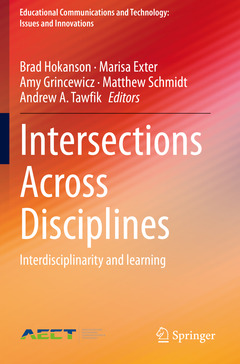Intersections Across Disciplines, 1st ed. 2021 Interdisciplinarity and learning Educational Communications and Technology: Issues and Innovations Series
Coordonnateurs : Hokanson Brad, Exter Marisa, Grincewicz Amy, Schmidt Matthew, Tawfik Andrew A.

This volume is the result of the annual Summer research symposium sponsored by the Association for Educational Communications and Technology (AECT). The twenty-two chapters in this volume seek to examine how learning and the design of instruction is interdisciplinary and connective in terms of research and practice.
The book is generally divided into three areas: Theory, Research, and Application. This framework shaped the authors? interactions, discussions, and the informal context of the symposium. Writings are included on multiple levels including research and practice on learning across disciplines, including instructional design and how design thinking is inherently interdisciplinary. How learning is designed for general audiences or for purposely integrated educational experiences has also been examined.
Brad Hokanson is a professor in Graphic Design at the University of Minnesota. He has a diverse academic record, including degrees in art, architecture, urban design, and received his Ph.D. in Instructional Technology. He teaches in the area of creative problem solving and has published research in the fields of creativity and educational technology. His most recent book is Developing Creative Thinking in Learners. He also currently is the Mertie Buckman Professor of Design Education. He won his colleges' awards for outstanding teaching in 2002 and 2008.
He has recently completed research on the relationship between creativity and achievement in school children, comparing measured creativity with standardized achievement scores. He is now running his fourth massive online course on creativity for the University of Minnesota with an enrollment of over 143,000. Previous courses each enrolled over 52,000 learners.
He served as President of the Association of Educational Communication and Technology in 2017. He has led the Summer Research Symposium since 2012, and has served as lead editor of the books for the last four volumes published with Springer.
Provides a diverse exploration of instructional design and learning
Highlights application-ready ideas for the field of instructional design
Includes contributions from experts in the field of instructional design
Date de parution : 12-2021
Ouvrage de 303 p.
15.5x23.5 cm
Date de parution : 12-2020
Ouvrage de 303 p.
15.5x23.5 cm
Thème d’Intersections Across Disciplines :
Mots-clés :
Interdisciplinary learning; Interdisciplinary education; Transdisciplinary education; Educational technology; Inquiry-based learning; Interdisciplinary curriculum design; Application of interdisciplinary research; Educational software design; Theory of interdisciplinary education; Improving reading speed for dyslexic readers; Teaching and assessing design thinking



